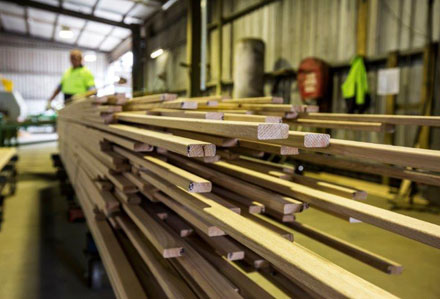
Claims there is not enough wood to supply the Heyfield sawmill are undermined by research showing that percentage-wise, Victoria has more than eight times the amount of forest in conservation reserves compared with Europe. Source: Latrobe Valley Express
Formal conservation reserves in Victoria effectively amount to 60% of the state’s native forest, but in Europe, the area of forest formally reserved for conservation averages just 7.1% per country, data from the Finnish Forest Research Institute shows.
A total of 26 European countries are included in the research.
In Victoria, only 6% of the native forest is available to industry, with the remaining 34% unproductive, inaccessible or unsuitable for commercial use.
A lack of resource threatens the survival of Australian Sustainable Hardwoods in Heyfield but could also potentially affect wood supply to Australian Paper, according to Victorian Environment Assessment Council estimates.
According to Victoria’s State of the Forests 2013 report, parks and conservation reserves constitute 3.98 million hectares – about 50% of public forests.
State Forest special protection zones, where the timber industry is prohibited, make up a further 753,000 ha, giving a total of 4.735 million ha in reserves – about 60% of the total.
With industry only accessing 6% of Victoria’s native forest, the non-industry forest effectively reserved for conservation totals 94%.
In Europe, the percentage of protected forest varies from country to country. In Austria, it’s 19.2%; the others include Belgium (0.1), Bulgaria (10.0), Finland (10.7), Croatia (7.3), Czech Republic (6.6), Denmark (0.2), France (1.2), Germany (4.0), Italy (6.4), Ireland (1.0), Norway (1.7), Russia (European 3.0) and Sweden (3.4). The largest is Spain (24.0).
This leaves a far greater share of Europe’s forests potentially available to industry on a sustainable basis. Europe is regarded as the home of sustainable forestry.
“The balance in Victoria is way out of kilter to the detriment of industry, regional communities and Victorians,” Institute of Foresters of Australia fellow and forestry historian Mark Poynter said.
Europe has considerably more productive forestry on private land than Victoria.
The 1999 European report was prepared by Jari Parviainen, head of the Finnish Forest Research Institute, as part of a process to create a European network of forest reserves and co-ordinate research, taking into account the diverse conditions in European forestry.
Like Australia’s Regional Forest Agreements, a catalyst for the research was the Earth Summit in Rio de Janeiro, Brazil in 1992.
The European research shows the close connection between sustainability, biodiversity and timber production.
Dr Parviainen said forest reserves in different European countries comprised natural and semi-natural forests. Original forest had decreased during the past centuries.
“The widest, continuous natural forests can be found in Finland and Sweden and in remote mountainous areas of Central and Eastern Europe,” he said.





